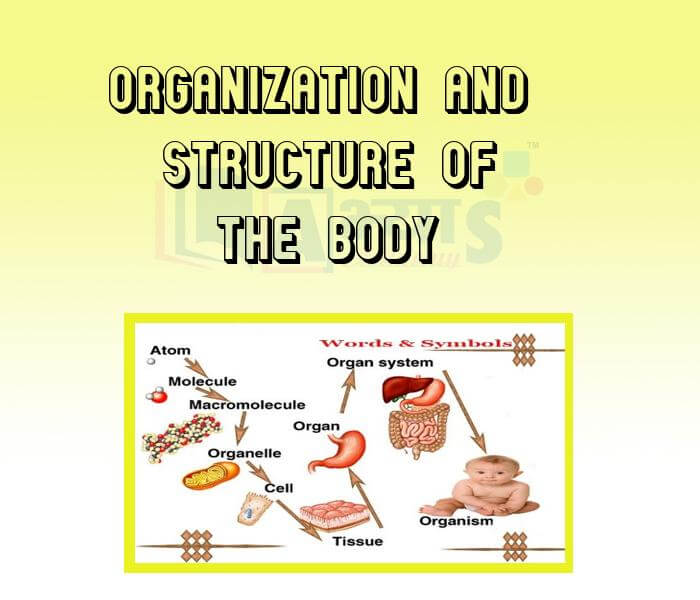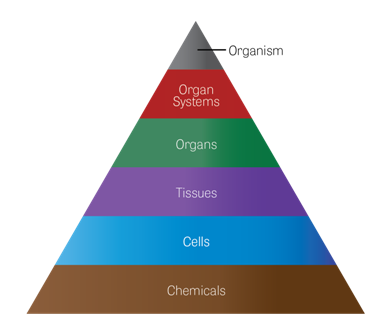Organization And Structure Of The Body


Organization And Structure Of The Body
All living things are made up of one or more cells. For this reason, cells are known as the structural units or the building blocks of life.
In an organism made up of only one cell (unicellular), the single cell performs all the activities necessary for life. In an organism made up of many cells (multicellular), the various life activities are performed by different groups of cell.
Organization of body :-
Cell :-
Cell is the smallest structural and functional unit of an organism. It is the building block of a living organism. It is a membrane bound and is made up of cytoplasm, genetic material and other cell organelles.
Tissue :
A group of cells that performs a special job together is known as a tissue. Blood, bone, muscle and skin are some of the tissues in your body. For example, muscle tissues are a group of cells, specialized to contract and expand for the movement of body parts.
Organ :
Tissues combine to form an organ. Each organ performs some important function of the body. For example, the heart is an organ that pumps blood to various parts of the body. The eye is an organ that enables you to see. Lungs, kidneys and liver are some other organs which perform important roles in your body.
Organ system :
Groups of organs work together to carry out various life activities in our body. For example the food pipe, stomach, small intestine, large intestine and some other organs together help you to digest the food you eat. Such a group of organs is called an organ system. The group of organs that carry out digestion of food collectively form the digestive system. Some other systems in your body are: circulatory, respiratory, nervous, urinary (or excretory), reproductive, muscular and skeletal system .
The main systems in the human body and their functions are given:
| ORGAN SYSTEM | MAIN ORGANS | MAIN FUNCTIONS |
| Skeletal system | bones | gives support to the body; protects internal organs; allow movement |
| Muscular system | muscles | movement of body parts |
| Circulatory system | heart, blood, blood vessels | transport nutrients and oxygen to all parts of body; transports waste |
| Nervous system | brain, spinal cord, nerves | controls all functions of the body |
| Respiratory system | nose, wind pipe, lungs | takes in oxygen and remove carbon dioxide gas |
| Digestive system | teeth, food pipe, stomach, small intestine, large intestine | Digest and absorb nutrients necessary for growth and maintainance of the body |
| Excretory system | kidneys,ureters,bladder, urethra, skin | removes waste from the body |
| Reproductive system | female : ovaries, oviducts, uterus, penis | produces offsprings |
All these systems together form your body. They all work to keep you alive. Thus, the human body, and the bodies of all multiceliular living organisms, are organized as follows:

Which of the following are correct : (a) Cell is the smallest structural and functional unit of an organism. (b) Blood, bone, muscle and skin are some of the tissues in your body. (c) A group of cells that performs a special job together is known as a tissue. | |||
| Right Option : D | |||
| View Explanation | |||
Select the one that is incorrect about cartilage. | |||
| Right Option : B | |||
| View Explanation |
A group of cells that performs a special job together is known as a ___________________. | |||
| Right Option : A | |||
| View Explanation | |||
Students / Parents Reviews [20]
Abhyas is an institute of high repute. Yogansh has taken admission last year. It creates abilities in child to prepare for competitive exams. Students are motivated by living prizes on basis of performance in Abhyas exams. He is satisfied with institute.

Yogansh Nyasi
7thAbhyas academy is great place to learn. I have learnt a lot here they have finished my fear of not answering.It has created a habit of self studying in me.The teachers here are very supportive and helpful. Earlier my maths and science was good but now it has been much better than before.

Barkha Arora
10thMy experience with Abhyas is very good. I have learnt many things here like vedic maths and reasoning also. Teachers here first take our doubts and then there are assignments to verify our weak points.

Shivam Rana
7thWhen I have not joined Abhyas Academy, my skills of solving maths problems were not clear. But, after joining it, my skills have been developed and my concepts of science and SST are very well. I also came to know about other subjects such as vedic maths and reasoning.

Sharandeep Singh
7thMy experience with Abhyas Academy has been very good. When I was not in Abhyas whenever teacher ask questions I could not speak it confidently but when I came in Abhyas, my speaking skills developed and now I am the first one to give the answer of teachers question.

Upmanyu Sharma
7thAbhyas institute is one of the best coaching institute in the vicinity of Ambala cantt.The institute provides good and quality education to the students.The teachers are well experienced and are very helpful in solving the problems. The major advantages of the institute is extra classes for weak...

Shreya Shrivastava
8thThird consective year,my ward is in Abhyas with nice experience of admin and transport support.Educational standard of the institute recumbent at satisfactory level. One thing would live to bring in notice that last year study books was distributed after half of the session was over,though study ...

Ayan Ghosh
8thAbhyas is good institution and a innovative institute also. It is a good platform of beginners.Due to Abhyas,he has got knoweledge about reasoning and confidence.My son has improved his vocabulary because of Abhyas.Teacher have very friendly atmosphere also.

Manish Kumar
10thAbhyas Methodology is very good. It is based on according to student and each child manages accordingly to its properly. Methodology has improved the abilities of students to shine them in future.

Manish Kumar
10thA marvelous experience with Abhyas. I am glad to share that my ward has achieved more than enough at the Ambala ABHYAS centre. Years have passed on and more and more he has gained. May the centre flourish and develop day by day by the grace of God.

Archit Segal
7thMy experience with Abhyas academy is very nice or it can be said wonderful. I have been studying here from seven class. I have been completing my journey of three years. I am tinking that I should join Abhyas Academy in tenth class as I am seeing much improvement in Maths and English

Hridey Preet
9thIt has a great methodology. Students here can get analysis to their test quickly.We can learn easily through PPTs and the testing methods are good. We know that where we have to practice

Barkha Arora
10thWe started with lot of hope that Abhyas will help in better understnding of complex topics of highers classes. we are not disappointed with the progress our child has made after attending Abhyas. Though need to mention that we expected a lot more. On a scale of 1-10, we would give may be 7.

Manya
8thIt was good as the experience because as we had come here we had been improved in a such envirnment created here.Extra is taught which is beneficial for future.

Eshan Arora
8thAbhyas is a complete education Institute. Here extreme care is taken by teacher with the help of regular exam. Extra classes also conducted by the institute, if the student is weak.

Om Umang
10thAbout Abhyas metholodology the teachers are very nice and hardworking toward students.The Centre Head Mrs Anu Sethi is also a brilliant teacher.Abhyas has taught me how to overcome problems and has always taken my doubts and suppoeted me.

Shreya Shrivastava
8thMy experience with Abhyas academy is very good. I did not think that my every subject coming here will be so strong. The main thing is that the online tests had made me learn here more things.

Hiya Gupta
8thIn terms of methodology I want to say that institute provides expert guidence and results oriented monitering supplements by requsite study material along with regular tests which help the students to improve their education skills.The techniques of providing education helps the students to asses...

Aman Kumar Shrivastava
10thBeing a parent, I saw my daughter improvement in her studies by seeing a good result in all day to day compititive exam TMO, NSO, IEO etc and as well as studies. I have got a fruitful result from my daughter.

Prisha Gupta
8thUsually we see institutes offering objective based learning which usually causes a lag behind in subjective examinations which is the pattern followed by schools. I think it is really a work of planning to make us students grab the advantages of modes of examination, Objective Subjective and Onli...
